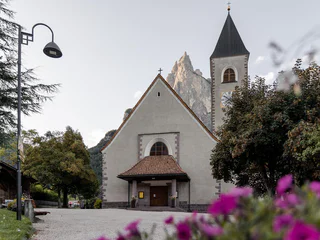
1/5
The Parish Church "Holy cross" of Seis
Siusi/Seis, Kastelruth/Castelrotto, Dolomites Region Seiser Alm
In de voetsporen van onze geschiedenis dwaal je door statige kastelen en paleizen, bezoek je kerken en kloosters en verken je hedendaagse getuigenissen, gebouwen en bezienswaardige plaatsen tijdens rondleidingen en bezoeken. Geïnspireerd door oude en nieuwe meesters, traditionele gebruiken en hedendaagse evenementen, nodigen de verschillende culturele evenementen zoals tentoonstellingen, theater, dans en muziek uit tot interactie met kunst en cultuur.

1/5
Siusi/Seis, Kastelruth/Castelrotto, Dolomites Region Seiser Alm

1/4
Cornedo all'Isarco/Karneid, Karneid/Cornedo all'Isarco, Dolomites Region Eggental

Dobbiaco Nuova/Neutoblach, Toblach/Dobbiaco, Dolomites Region 3 Zinnen

1/2
Sesto/Sexten, Sexten/Sesto, Dolomites Region 3 Zinnen

Dobbiaco Nuova/Neutoblach, Toblach/Dobbiaco, Dolomites Region 3 Zinnen

1/2
S.Cristina Gherdëina/S.Cristina Val Gardena/S.Cristina Gherdëina/St.Christina in Gröden, S.Crestina Gherdëina/Santa Cristina Val Gardana, Dolomites Region Val Gardena

1/3
S.Cristina Gherdëina/S.Cristina Val Gardena/S.Cristina Gherdëina/St.Christina in Gröden, S.Crestina Gherdëina/Santa Cristina Val Gardana, Dolomites Region Val Gardena

Sesto/Sexten, Sexten/Sesto, Dolomites Region 3 Zinnen

Tiso/Teis, Villnöss/Funes, Dolomites Region Villnösstal

1/7
Pescosta/Pescosta, Corvara, Dolomites Region Val Gardena

1/3
San Vigilio, Al Plan/San Vigilio, Dolomites Region Kronplatz/Plan de Corones

Merano/Meran, Meran/Merano, Dolomites Region Val Gardena

Brunico città/Bruneck Stadt, Bruneck/Brunico, Dolomites Region Kronplatz/Plan de Corones

1/8
Alpe di Siusi/Seiseralm, Kastelruth/Castelrotto, Dolomites Region Seiser Alm

1/3
Piccolino/Pikolein, San Martin /San Martino, Dolomites Region Kronplatz/Plan de Corones

1/2
Dobbiaco Nuova/Neutoblach, Toblach/Dobbiaco, Dolomites Region 3 Zinnen

Siusi/Seis, Kastelruth/Castelrotto, Dolomites Region Seiser Alm

Roncadizza/Runggaditsch - Ortisei/St.Ulrich, Urtijëi/Ortisei, Dolomites Region Val Gardena

1/13
Casteldarne/Ehrenburg, Kiens/Chienes, Dolomites Region Kronplatz/Plan de Corones

1/3
Fiè/Völs, Völs am Schlern/Fiè allo Sciliar, Dolomites Region Seiser Alm

1/3
Dobbiaco Nuova/Neutoblach, Toblach/Dobbiaco, Dolomites Region 3 Zinnen

1/3
Mitterolang/Valdaora di Mezzo, Olang/Valdaora, Dolomites Region Kronplatz/Plan de Corones

Collepietra/Steinegg, Karneid/Cornedo all'Isarco, Dolomites Region Eggental

1/2
Tiso/Teis, Villnöss/Funes, Dolomites Region Villnösstal

1/5
S. Candido/Innichen, Innichen/San Candido, Dolomites Region 3 Zinnen

1/3
Siusi/Seis, Kastelruth/Castelrotto, Dolomites Region Seiser Alm

Selva/Sëlva/Wolkenstein/Sëlva, Sëlva/Selva di Val Gardena, Dolomites Region Val Gardena

1/4
Ortisei/Urtijëi/St. Ulrich/Urtijëi, Urtijëi/Ortisei, Dolomites Region Val Gardena

1/2
Dobbiaco Nuova/Neutoblach, Toblach/Dobbiaco, Dolomites Region 3 Zinnen

Rasun di Sopra/Oberrasen, Rasen-Antholz/Rasun Anterselva, Dolomites Region Kronplatz/Plan de Corones